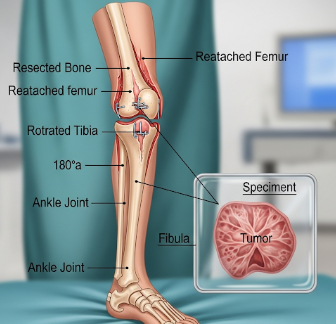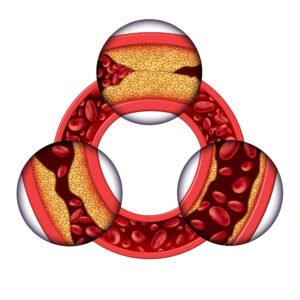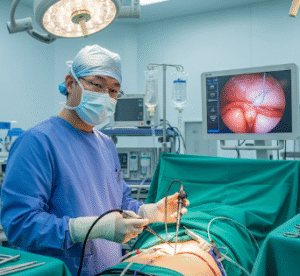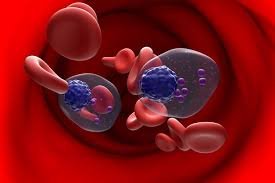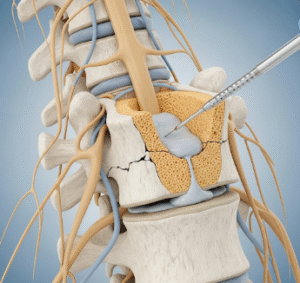Overview
Rotationplasty is a complex orthopedic surgical procedure primarily used for children and young adults with bone cancer (usually around the knee) or severe limb deficiencies. The surgery removes a diseased portion of the leg and reattaches the lower leg rotated 180 degrees, allowing the ankle to function as a knee joint when fitted with a prosthesis.
South Korea is known for advanced orthopedic oncology centers, expert limb-sparing surgeons, and state-of-the-art rehabilitation programs, ensuring rotationplasty is performed safely and effectively.
What is Rotationplasty?
Rotationplasty is a limb-sparing procedure where:
✔ The affected section of the femur or knee is removed.
➔ The lower leg is rotated 180° and reattached, allowing the ankle to function as a knee joint.
● Prosthetic fitting enables near-normal walking and mobility.
★ Primarily indicated for children or young adults with bone tumors, congenital limb deficiencies, or severe trauma.
This procedure is chosen when traditional amputation or limb-salvage options may not provide sufficient function. It allows patients to maintain active lifestyles, including sports and daily activities.
What are the Benefits?
Rotationplasty offers several advantages:
✔ Preserves limb length and function.
➔ Enables active mobility and prosthetic use.
● Durable solution for tumor removal or severe limb deformity.
★ High long-term functionality, especially in young, active patients.
➤ Better outcomes than traditional above-knee amputation in terms of energy efficiency and gait.
Procedure Details
1) How should I prepare for Rotationplasty?
Preparation ensures safety and optimal outcomes:
✔ Medical evaluation: Imaging (X-ray, MRI, CT) to assess tumor size, bone structure, and vascular anatomy.
➔ Lab tests and overall health assessment to optimize healing.
● Medication review: Adjust blood thinners or medications affecting bone healing.
★ Preoperative counseling: Discuss procedure, prosthetic fitting, expected outcomes, and possible complications.
➤ Physical assessment: Evaluate strength, joint mobility, and rehabilitation potential.
2) What happens during the Rotationplasty procedure?
The surgery is performed in a specialized orthopedic operating room under general anesthesia:
✔ Tumor or affected bone resection: Diseased segment is removed with clear margins.
➔ Rotation of lower limb: Lower leg is rotated 180° and aligned for optimal ankle function as a knee joint.
● Reattachment: Bones fixed with internal hardware (plates, screws) and soft tissues repaired.
★ Closure: Incisions closed with sutures; sterile dressings applied.
➤ Procedure duration: Typically 4–6 hours depending on complexity and patient anatomy.
Korean surgeons focus on precise alignment, vascular preservation, and soft tissue repair to maximize prosthetic function and minimize complications.
3) What happens after Rotationplasty?
Post-operative care emphasizes pain control, wound healing, and gradual rehabilitation:
✔ Hospital stay: Usually 1–2 weeks for monitoring, pain management, and initial physiotherapy.
➔ Pain management: IV and oral analgesics; nerve blocks may be used.
● Wound care and infection prevention: Strict hygiene and monitoring of incisions.
★ Physical therapy: Focused on strengthening, ankle training, and gait adaptation with prosthesis.
➤ Prosthetic fitting: Typically several weeks after surgery once healing allows weight-bearing.
Risks / Benefits
Possible Risks:
✔ Infection at surgical site
➔ Bleeding or hematoma
● Non-union or delayed bone healing
★ Nerve or vascular injury
➤ Prosthetic fitting challenges if alignment or rotation is suboptimal
Major Benefits:
✔ Preserves limb function and length
➔ Enables active mobility and prosthetic use
● High long-term durability in young, active patients
★ Better energy efficiency and gait compared to above-knee amputation
➤ Allows participation in sports and daily activities
Recovery and Outlook
✔ Immediate recovery: Pain, swelling, and bruising monitored in hospital; early physiotherapy begins.
➔ Hospital stay: 1–2 weeks, depending on healing and patient age.
● Activity: Gradual weight-bearing with guidance; prosthetic training starts several weeks post-op.
★ Long-term outcome: Most patients achieve functional mobility, participate in sports, and have excellent quality of life.
➤ Follow-up: Regular imaging, rehabilitation assessments, and prosthetic adjustments.
When To Call the Doctor
Contact your doctor immediately if you notice:
✔ Fever, chills, or signs of infection
➔ Severe or worsening pain
● Swelling, redness, or discharge at surgical site
★ Numbness, tingling, or loss of function in the limb
➤ Problems with prosthetic fitting or alignment
Best Korea Option / Process
South Korea provides expert rotationplasty services with:
✔ Leading hospitals: Samsung Medical Center, Asan Medical Center, Severance Hospital Orthopedics & Oncology.
➔ Experienced limb-sparing orthopedic surgeons specializing in tumor resection and rotationplasty.
● Advanced imaging and surgical technology for precise planning and execution.
★ Comprehensive rehabilitation programs to maximize functional outcomes with prosthesis.
➤ Medical tourism support: Translation services, appointment coordination, and continuity of care for international patients.
✅ Highlights:
✔ Rotationplasty preserves limb function and allows prosthetic mobility
➔ Ideal for bone tumors, congenital deformities, or severe trauma
● High long-term functional outcomes and quality of life
★ Risks include infection, bleeding, nerve injury, delayed bone healing, or prosthetic challenges
➤ Korean hospitals provide expert surgeons, advanced technology, and comprehensive post-op rehabilitation

